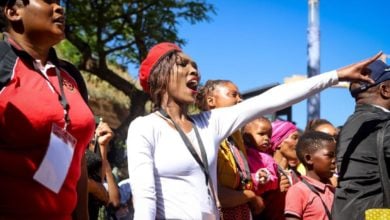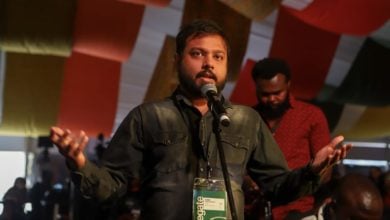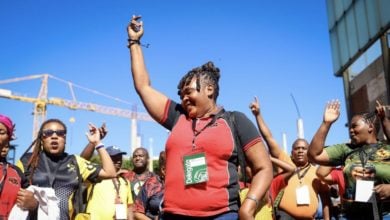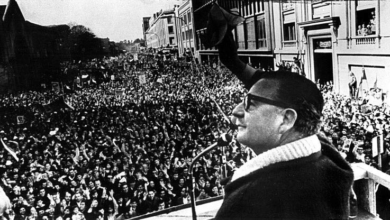Fifty years ago in October 1966, the Black Panther party exploded onto the political scene in the United States, striking fear into the racist ruling class and inspiring a new generation of revolutionaries to “seize the time.”
Today, there is a renewed interest in the Panthers and what they stood for. The slogan “Assata taught me” is widespread in the Movement for Black Lives. Huey P. Newton’s Revolutionary Suicide, Bobby Seale’s Seize the Time, Assata Shakur’s self-titled autobiography and George Jackson’s Soledad Brother, among many other books by former Panthers, are staples of any revolutionary library.
In the face of the ongoing racism, police terror and segregation that Black people and oppressed people face today, it is more important than ever to review the history of the Black Panther Party, and examine how it dealt with these same issues.
The meteoric rise of the Panthers
Revolution seemed to be on the agenda during the 1960s – in the United States and around the world.
In plain view of a television audience of millions, the police departments of the South employed attack dogs, batons, water hoses and other weapons to repress the right of Black people to vote and to uphold segregation. After much sacrifice, the Civil Rights movement won the passage of the Civil Rights Act in 1964 and the Voting Rights Act in 1965. Even though these acts declared Jim Crow practices illegal, the majority of Black people, in the South and in the North as well, still lived a precarious existence in either urban slums or impoverished rural areas, where they faced unemployment, substandard housing, disproportionate poverty and police harassment.
Inspired by the anti-colonial and socialist struggles worldwide, many came to the conclusion that nothing short of a revolutionary overturn of the entire system could defeat white supremacy. As the 1960s went on, the epicenter of struggle shifted from the south to the cities and suburbs of the north, and from tactical non-violence to active self-defense.
Malcolm X became the most influential voice of the Black Power movement. Local North Carolina NAACP leader Robert Williams, the Harlem 9’s Mae Mallory and organizations such as the Deacons for Defense armed themselves to stand up to the racist terror of the Ku Klux Klan and sheriff departments across the South. In Alabama, the Student Non-violent Coordinating Committee (SNCC)-affiliated Lowndes County Freedom Organization selected a black panther as the symbol of their struggle. LCFO Chairman John Hulett explained the symbol’s significance: “The Panther is an animal that when pressured moves back until it is cornered, then it comes out fighting for life and death. We felt we had been pushed back long enough and that it was time for Negroes to come out and take over.” (see Black against Empire: the History and Politics of the BPP by Joshua Bloom and Waldo E. Martin).
A pivotal moment had arrived in the history of the Black liberation movement.
In October of 1966, a year after the assassination of Malcolm X, college students Huey P. Newton and Bobby Seale formed the Black Panther Party for Self-Defense in Oakland, Calif., to stand up to police terror and continue the struggle for Black self-determination. The revolutionary political organization they formed became a lightning rod for oppressed Black youth and went on to become one of the most advanced expressions of working and oppressed people’s organization in the history of the United States.
The Panthers gained national prominence after a dramatic action on May 2, 1967, when 30 Black Panthers—dressed in black leather coats, and armed with unloaded shotguns—entered the capital building in Sacramento to protest the Mulford Act, a measure designed to outlaw citizens’ right to carry weapons. As Governor Ronald Reagan and other politicians scampered away, BPP chairman Bobby Seale read a statement to “the American people in general and the Black people in particular,” detailing “the terror, brutality, murder, and repression of Black people by the racist power structure of America,” and concluding that “the time has come for Black people to arm themselves against this terror before it is too late.” As reporters and cameramen shuffled to capture tomorrow’s headline, one reporter shouted out “who are you?”
Sixteen-year-old Bobby Hutton, who would be martyred after a confrontation with police the next year, capturing the militant attitude that now gripped the nation, responded, “We’re the Black Panthers. We’re Black people with guns. What about it?”
A few months later, Huey Newton was arrested and charged with murdering a police officer. The Panthers formed a broad coalition of radical and progressive organization and individuals that carried out a massive campaign to save him from execution. The demand “Free Huey!” echoed across the country, and in 1970 Huey Newton was released from prison.
By 1969 the Panthers were a national organization of 5,000 members with a median age of 19. The majority of Black Panther members were women.
The Panther’s guiding philosophy: Marxism-Leninism
Black Panther Party Chairman Bobby Seale wrote in his book Seize the Time, the “historical experience of black people, translated through Marxism-Leninism, is really the ideology of the Black Panther Party.”
The Black Panther Party was born into a world where socialist revolution had tremendous prestige. From the Soviet Union to China to Cuba, over a third of the world’s population lived in countries whose governments aspired to build socialism. The Panthers saw their struggle against racism and national oppression as part of this worldwide movement to break free of imperialism.
In China at that time the Cultural Revolution brought millions of young people into the streets, sparking interest worldwide. Bobby Seale and Huey Newton raised money for the newly formed Panthers by selling copies of “Quotations from Chairman Mao,” popularly known as The Little Red Book.
The Panthers were heavily influenced by Malcolm X. They also had the highest regard for the writings of Franz Fanon and the Marxist classics as the best guides for developing their own strategy for revolution and their own tactics for uplifting their communities. As Panther Field Marshal George Jackson said, “I met Marx, Lenin, Trotsky, Engels, and Mao when I entered prison and they redeemed me.”
Building off of the slogan and ideology of the Chinese Communist Party, “to serve the people,” the Panthers established breakfast programs in hundreds of cities across the country. In a sense, the BPP invented the term “grass roots,” developing a series of survival programs that responded to the complex problems that plagued oppressed communities, such as hunger, inadequate housing, drug and alcohol addiction, gangs, sexual violence and internalized self-hatred.
They saw these survival programs, and their armed cop watch patrols, as a way to elevate the morale of their communities and attract people to socialism. The Panthers emphasized building a revolutionary united front because they understood that only the toppling of the white supremacist, capitalist order and the establishment of a socialist system would begin to seriously resolve the needs of all oppressed communities.
What the Panthers did: Centralism, training and internationalism
The Panther leadership developed a 6-week training program for the youth who lined up across the country to join them. They encouraged the party membership to read an average of two hours per day and study the origins of the class and race oppression that affected Black America. The Black Panthers operated according to the organizational model of democratic centralism, where there is unity in action and members are held to a high standard of discipline and dedication.
The BPP educated the youth and they put them to work in the community. The Panthers’ leadership and confidence helped thousands of young Black people establish a new, revolutionary identity. Claudia Chesson-Williams, a teenage member in Corona, Queens describes the galvanizing effect the Panthers had:
“No longer did we have to argue and fight about ‘What are you looking at me like that for?’ and ‘Don’t step on my sneaker’ and ‘This is my block.’ Now, we really had something to fight for. We had a people to fight for. That was bigger than any gang or any club. We had a goal. We had something to look forward to, which was the betterment of Black people.”
The panthers developed 35 survival programs. They distributed free food and served free breakfasts for children (at one point for 20,000). They organized liberation schools, GED classes, benefits counseling, free clinics, plumbing and maintenance programs, martial arts programs, a Sickle Cell Anemia research foundation, a visiting nurses program, legal aid and more.
Their political organ, the Black Panther: Black Community News Service, was read nationally.
Chairman Fred Hampton formed the original Rainbow Coalition in order to unite different revolutionary groups and ex-gangs into one united front.
Before many groups dared to take a stance against the oppression of LGBTQ people, in 1970, just one year after the Stonewall Rebellion, the Panthers took a public stance recognizing that LGBTQ liberation was an important part of the liberation of all oppressed people.
The Panthers were among the strongest proponents of international solidarity. The Panthers not only opposed Washington’s war on Vietnam, they also offered their members as soldiers to fight on the side of the Vietnamese against the Pentagon. In 1970, the Panthers gave full support to Palestinian liberation when few groups did.
The Panthers’ example inspired other national liberation struggles within the American “prison-house of nations” – a term coined by Lenin to describe the Russian Empire but one that also applies to the United States, where the oppressed Black, Chicano, Puerto Rican, Indigenous nations and others are denied self-determination. The American Indian Movement, the Young Lords, the Brown Berets, the Grey Panthers and other groups emulated the Panthers’ example of self-sacrifice and centralism. We should remember that it was in a Chicago jail cell that Cha Chi Jimenez, the founder of the Young Lords, met Chairman Fred Hampton.
State repression
Despite these amazing achievements in just a few years, the Panthers were never allowed to reach their full potential. The U.S. government intervened to repress them. FBI director J. Edgar Hoover classified the Panthers as “the greatest threat to the internal security of the country.”
Why did the U.S. government see the Panthers as a threat? Mumia Abu-Jamal explains, “It was terrified that the [Panthers] had the ability to put forward leaders to channel the mass defiance of the 1960s, growing especially militant among African American communities, into a potent revolutionary movement.”
What differentiated the Panthers from other service organizations and what made them dangerous to the ruling class was their analysis that popularized a socialist revolution to overthrow white supremacy. For instance, Assata Shakur wrote:
“I wasn’t against communism, but i can’t say i was for it either. At first, i viewed it suspiciously, as some kind of white man’s concoction, until i read works by African revolutionaries and studied the African liberation movements. Revolutionaries in Africa understood that the question of African liberation was not just a question of race, that even if they managed to get rid of the white colonialists, if they didn’t rid themselves of the capitalistic economic structure, the white colonialists would simply be replaced by Black neocolonialists. There was not a single liberation movement in Africa that was not fighting for socialism … The whole thing boiled down to a simple equation: anything that has any kind of value is made, mined, grown, produced, and processed by working people. So why shouldn’t working people collectively own that wealth? Why shouldn’t working people own and control their own resources? Capitalism meant that rich businessmen owned the wealth, while socialism meant that the people who made the wealth owned it.”
A fighting organization with a wide following among the people and this type of ideological orientation was nothing short of an existential threat to the U.S. ruling class.
COINTELPRO (Counter Intelligence Program) was a sophisticated FBI effort to infiltrate and liquidate the BPP. In conjunction with police departments across the country, FBI Director J. Edgar Hoover coordinated a massive campaign of misinformation, infiltration and extermination against the Panthers. 28 Panther leaders were assassinated, among them Bobby Hutton, Bunchy Carter, John Huggins, Fred Hampton, Mark Clark and George Jackson.
It was not until years later that the Senate’s Church Committee would show how pervasively the FBI worked against the Panthers and how much it influenced press coverage. It encouraged urban police forces to confront Black Panthers, planted informants and agent provocateurs, and intimidated local community members who were sympathetic to the group.
While the state liquidated the Black freedom fighters with one hand, they implemented token reforms with the other. The liberal wing of the establishment propped up networks of non-profits and CBO’s (Community-Based Organizations) to give the illusion that the government was involved in rendering basic services. These two strategies of “pacification” were aimed at removing the true forces of liberation from the heart of oppressed communities. The new “grass-roots” were funded and directed from on high, from the outside, so that they became dead-ends for popular energy and anger.
Panther leaders like Mutulu Shakur, Mumia Abu Jamal and Russel “Maroon” Shoatz continue to languish in prison today because of their uncompromising defense of the right of Black people to self-determination. Assata Shakur, who describes herself as a modern day run-away slave and maroon, is in exile in Cuba with a $2 million bounty on her head. Anyone who repeats the meaningless cliché that “the U.S. is the freest country in the world” should study the history of the Panthers.
But for all the repression, 50 years later the Black Panther spirit lives on. Its historic legacy – and the active mentorship still provided by former Panthers to a new generation of radicals – can never be erased. The task ahead of us is to revive the revolutionary movement, construct the revolutionary party and seize power to build socialism – we will win!





